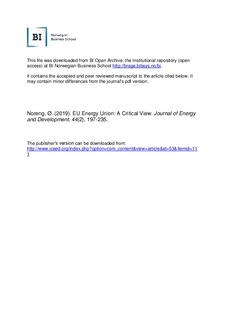| dc.contributor.author | Noreng, Øystein | |
| dc.date.accessioned | 2019-11-26T14:35:46Z | |
| dc.date.available | 2019-11-26T14:35:46Z | |
| dc.date.created | 2019-11-20T10:02:14Z | |
| dc.date.issued | 2019 | |
| dc.identifier.citation | Journal of Energy and Development. 2019, 44 (2), 197-235. | nb_NO |
| dc.identifier.issn | 0361-4476 | |
| dc.identifier.uri | http://hdl.handle.net/11250/2630619 | |
| dc.description.abstract | This paper discusses the Energy Union project of the current European Union (EU), asmanifest in the 2018 Clean Energy for All.1 The focus is on energy policy objectives in relation to wider political ambitions, using energy policy to further convergence and integration of member countries, centralizing authority, and strengthening Brussels’ authority. Emphasis is on the interaction between France and Germany as the historical driving force.2 The discussion will focus on policies and performance since the finance crisis in 2008–2009. The overriding objective is to reduce greenhouse gas emissions by 85 to 90 percent by 2050 from their 1990 levels. Indeed, from that perspective, the EU energy policy is to a large extent about climate. | nb_NO |
| dc.description.abstract | EU Energy Union: A Critical View | nb_NO |
| dc.language.iso | eng | nb_NO |
| dc.title | EU Energy Union: A Critical View | nb_NO |
| dc.type | Journal article | nb_NO |
| dc.type | Peer reviewed | nb_NO |
| dc.description.version | acceptedVersion | nb_NO |
| dc.source.pagenumber | 197-235 | nb_NO |
| dc.source.volume | 44 | nb_NO |
| dc.source.journal | Journal of Energy and Development. | nb_NO |
| dc.source.issue | 2 | nb_NO |
| dc.identifier.cristin | 1749718 | |
| cristin.unitcode | 158,4,0,0 | |
| cristin.unitname | Institutt for ledelse og organisasjon | |
| cristin.ispublished | true | |
| cristin.fulltext | postprint | |
| cristin.qualitycode | 1 | |
